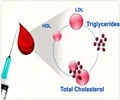Researchers at the Wake Forest University School of Medicine developed a breed of research mice to decipher the complexities of cholesterol.
Researchers at the Wake Forest University School of Medicine developed a breed of research mice to decipher the complexities of cholesterol.
It studies how "good" cholesterol is used by the body to protect against heart attacks and strokes.According to John S. Parks, Ph.D., from Wake Forest University School of Medicine, “Being able to develop drugs to raise levels of good cholesterol depends on knowing more about the how and where the particles are formed. These animals provide the first tools to address these questions."
These specially developed mice have mutations in a gene (ABCA1) involved in HDL production. In one group of animals, the ABCA1 gene is selectively deleted in the liver – which means their livers cannot produce HDL. It was through studying these mice that the scientists were able to report in 2005 that the liver is likely the body's main source of good cholesterol – producing 70 to 80 percent.
Scientists also know that very small amounts of HDL are produced in macrophages, cells in the blood vessel walls that are involved in the formation of plaques. Through studying the third group of mice – which produces no HDL in the vessel walls – the scientists hope to answer a conundrum about this source of good cholesterol. Previous research indicates that while the levels of HDL produced in the vessels are very small, it may play a large role in keeping the vessels healthy.
"The animals can help us determine which pathways are affected by drug therapy, which can eventually be translated to human studies. They are a valuable tool in the quest to find a therapy to raise HDL concentrations and retard the development of heart disease,” said Parks. "










